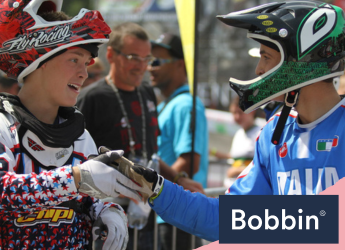What Is a Kid’s BMX Helmet?
Ensuring your child’s safety during BMX adventures is paramount. This is where a properly fitted bike helmet comes into play. In this guide, we’ll go through the basics to understand the key aspects. From the unique features to decoding safety standards, know what makes up this gear. Learn how to choose the right size and explore various styles and designs. Read on!
BMX Helmets Explained

A BMX helmet is designed to provide essential protection during BMX activities. Its primary purpose is to safeguard a rider’s head from potential impacts. This, in turn, reduces the risk of injury in the dynamic and fast-paced world of BMX riding.
What sets them apart are their distinctive features tailored to the demands of the sport. These childrens bike helmets typically have the:
- a robust outer shell
- enhanced padding for impact absorption
- increased coverage around the back of the head
Emphasising a proper fit is paramount. So, make sure the helmet stays securely in place during manoeuvres. A snug fit is crucial for both comfort and maximising the helmet’s protection. Check out our kids bike helmet sizes guide for reference.
Safety Standards and Certifications
These standards establish specific safety criteria that helmets must meet. They are often set by regulatory bodies. Examples include certifications like:
- CE EN1078: Helmets with this certification have undergone testing for impact resistance. Plus, for other essential safety criteria. It signifies that a helmet meets the safety requirements.
- BSI (British Standards Institution) Kitemark: A widely recognised mark of quality and safety.
These certifications ensure that the helmet undergoes rigorous testing to meet safety requirements. For instance, impact tests assess the helmet’s ability to absorb energy during a crash. As for the strap strength tests, it evaluates the integrity of the chinstrap. Following these standards confirms that a BMX helmet meets crucial safety requirements. As a parent, selecting helmets with these certifications gives peace of mind.
Components of a Kid’s BMX Helmet

(Image Credit: Wallpaper Flare)
The outer shell serves as the first line of defence. It absorbs initial impact forces and provides structural integrity. The material for this component is typically made of sturdy polycarbonate or fibreglass.
Beneath the shell, you’ll find an impact-absorbing foam liner. It is often composed of expanded polystyrene (EPS) or similar materials. Its purpose is to cushion the head during collisions, minimising injury. Another is the ventilation systems, consisting of placed vents, facilitate airflow. Such features keep the rider cool and comfortable.
The retention system, usually a secure chinstrap, ensures the helmet stays in place. It maintains its protective position during rides. Some helmets also feature additional padding for enhanced comfort and fit customisation. Understanding the material used in construction is key to making informed choices. With this knowledge, you can choose a durable one and absorb impacts effectively.
Sizing and Fitting
Measuring your child’s head for the right helmet size is a simple but crucial safety step for BMX rides. To guide you, use a flexible tape measure and wrap it around the widest part of the head, just above the eyebrows. Take note of the measurement and refer to the manufacturer’s sizing chart.
Achieving a snug and secure fit is equally vital. Adjust the helmet straps to form a V-shape under the ears, with the buckle comfortably snug under the chin. Ensure the helmet sits level on the head for optimal protection. Top tip: Here’s how to measure for cycle helmet.
Styles and Designs
Discover a variety of styles and designs when choosing BMX helmets for kids. From vibrant colours to sleek patterns, there are options to suit every young rider’s taste. Dive into helmets with additional features designed for enhanced comfort and aesthetics. Look for adjustable straps to achieve a customised fit. Some helmets come with extra padding for added comfort during longer rides. Explore ventilation systems that keep the head cool and contribute to the design.
Maintenance and Care
Providing proper care is essential for the helmet’s longevity and effectiveness. Start by regularly cleaning with a mild soap and water solution, ensuring it stays free of dirt and sweat. Avoid using harsh chemicals that may compromise its integrity.
Store in a cool, dry place away from direct sunlight to prevent material degradation. Don’t forget to inspect to identify any signs of wear and tear regularly. Check for cracks, dents, or any damage to the shell and foam liner. Ensure the straps and buckles are in good condition and adjust them for a secure fit. Following these ensures your child’s helmet offers reliable protection on every ride.
Round-up
To wrap up, keeping your child safe on Kid's BMX Bike starts with choosing the right helmet. Learn about construction, safety standards, and maintenance for optimal protection. From sizing to styles, each aspect adds to a safer ride. Follow these tips to empower your child. Let them enjoy BMX with confidence, knowing they’re well-protected on every adventure.
Explore our selection of bike helmets, catering to toddler helmets and adult helmets. Discover the perfect fit for you and your little ones today at Bobbin! Up next on your reading list: How Should Your Bike Helmet Fit?







